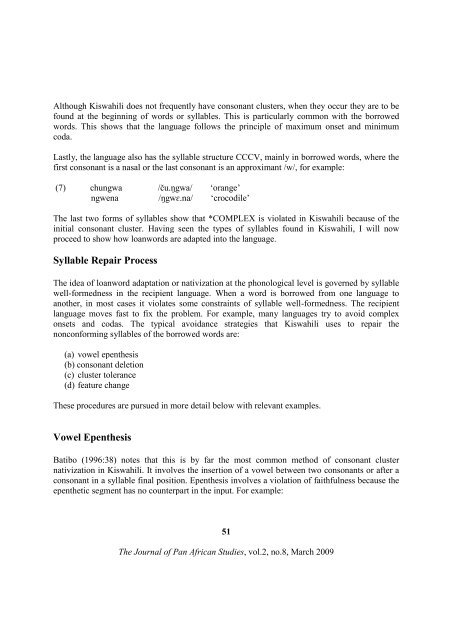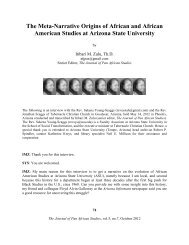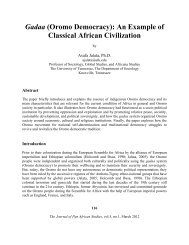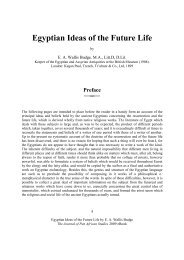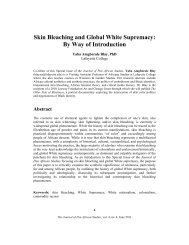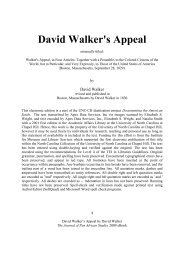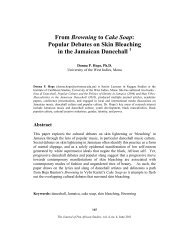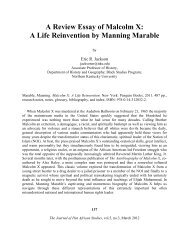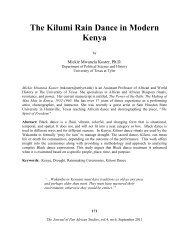The Adaptation of Swahili Loanwords From Arabic - Journal of Pan ...
The Adaptation of Swahili Loanwords From Arabic - Journal of Pan ...
The Adaptation of Swahili Loanwords From Arabic - Journal of Pan ...
Create successful ePaper yourself
Turn your PDF publications into a flip-book with our unique Google optimized e-Paper software.
Although Kiswahili does not frequently have consonant clusters, when they occur they are to be<br />
found at the beginning <strong>of</strong> words or syllables. This is particularly common with the borrowed<br />
words. This shows that the language follows the principle <strong>of</strong> maximum onset and minimum<br />
coda.<br />
Lastly, the language also has the syllable structure CCCV, mainly in borrowed words, where the<br />
first consonant is a nasal or the last consonant is an approximant /w/, for example:<br />
(7) chungwa /ču.ŋgwa/ ‘orange’<br />
ngwena /ŋgwɛ.na/ ‘crocodile’<br />
<strong>The</strong> last two forms <strong>of</strong> syllables show that *COMPLEX is violated in Kiswahili because <strong>of</strong> the<br />
initial consonant cluster. Having seen the types <strong>of</strong> syllables found in Kiswahili, I will now<br />
proceed to show how loanwords are adapted into the language.<br />
Syllable Repair Process<br />
<strong>The</strong> idea <strong>of</strong> loanword adaptation or nativization at the phonological level is governed by syllable<br />
well-formedness in the recipient language. When a word is borrowed from one language to<br />
another, in most cases it violates some constraints <strong>of</strong> syllable well-formedness. <strong>The</strong> recipient<br />
language moves fast to fix the problem. For example, many languages try to avoid complex<br />
onsets and codas. <strong>The</strong> typical avoidance strategies that Kiswahili uses to repair the<br />
nonconforming syllables <strong>of</strong> the borrowed words are:<br />
(a) vowel epenthesis<br />
(b) consonant deletion<br />
(c) cluster tolerance<br />
(d) feature change<br />
<strong>The</strong>se procedures are pursued in more detail below with relevant examples.<br />
Vowel Epenthesis<br />
Batibo (1996:38) notes that this is by far the most common method <strong>of</strong> consonant cluster<br />
nativization in Kiswahili. It involves the insertion <strong>of</strong> a vowel between two consonants or after a<br />
consonant in a syllable final position. Epenthesis involves a violation <strong>of</strong> faithfulness because the<br />
epenthetic segment has no counterpart in the input. For example:<br />
51<br />
<strong>The</strong> <strong>Journal</strong> <strong>of</strong> <strong>Pan</strong> African Studies, vol.2, no.8, March 2009


